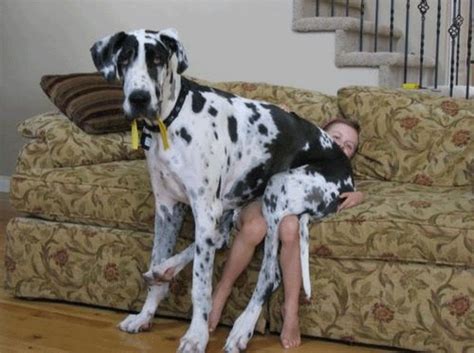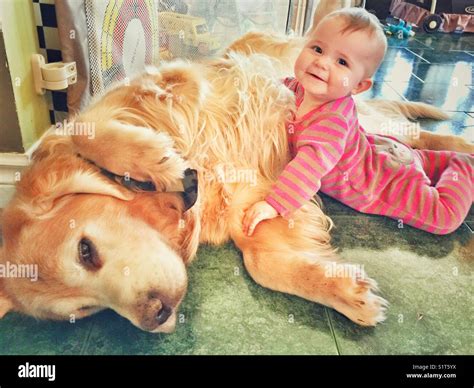
A Great Dane named Roo is captivating the internet with his uncanny impression of a goat, complete with bleating sounds and playful headbutts. Videos of Roo’s unusual behavior have gone viral, leaving viewers in stitches and sparking a wave of amusement across social media platforms.
Roo, a gentle giant by breed standards, displays a peculiar habit that has baffled and delighted his owners. Instead of typical canine vocalizations, Roo emits a series of bleats that are strikingly similar to those of a goat. This, coupled with his tendency to playfully headbutt objects and people, has led many to jokingly conclude that Roo believes he is, in fact, a goat.
“He’s just a goofy dog,” says Roo’s owner. “We never taught him to do this. It just started happening one day, and we couldn’t stop laughing.”
The videos showcase Roo engaging in his signature goat-like antics. In one clip, he can be seen bleating incessantly while nudging a soccer ball with his head. In another, he greets his owners with a series of playful headbutts accompanied by his trademark bleating sounds. The internet has embraced Roo’s quirky behavior, with many users commenting on the uniqueness and humor of the situation.
The phenomenon has ignited discussions about animal behavior and the potential for cross-species mimicry. While the exact reasons behind Roo’s behavior remain a mystery, experts suggest that it could be a form of learned behavior, a playful imitation, or simply a unique quirk in his personality.
The internet’s reaction to Roo has been overwhelmingly positive, with many users expressing their amusement and admiration for the Great Dane’s unusual talent. Roo’s videos have garnered millions of views and shares, solidifying his status as an internet sensation. His story serves as a reminder of the joy and laughter that animals can bring into our lives.
The attention surrounding Roo highlights the power of social media to amplify heartwarming and humorous stories. His unusual behavior has not only entertained millions but has also sparked curiosity and discussion about animal behavior. Roo’s story is a testament to the unique personalities of animals and the joy they bring to our lives.
The Great Dane, known for its imposing size and gentle nature, is a popular breed around the world. Bred initially for hunting boar, these dogs transitioned into guardians and companions. The breed’s distinctive traits, including their height and muscular build, make them easily recognizable. While Great Danes are generally known for their docile and friendly temperament, Roo’s case presents a unique twist on the breed’s typical behavior.
Veterinarians have weighed in on Roo’s unusual behavior, suggesting various potential explanations. Some believe that Roo may have been exposed to goats at a young age, leading him to mimic their vocalizations and mannerisms. Others suggest that it could be a form of play, with Roo simply enjoying the attention and reaction he receives from his owners. Regardless of the reason, experts agree that Roo’s behavior is not harmful and is simply a unique quirk that adds to his charm.
The story of Roo the Great Dane has resonated with animal lovers and internet users alike, proving that even the most unexpected behaviors can bring joy and laughter into our lives. His viral videos serve as a reminder of the unique personalities of animals and the power of social media to connect people through shared experiences.
In-Depth Analysis and Background Information:
The case of Roo the Great Dane, who seemingly believes he is a goat, presents a fascinating intersection of animal behavior, social media virality, and human-animal interaction. To understand the phenomenon fully, it’s necessary to delve into various aspects, including the Great Dane breed characteristics, animal behavior theories, the impact of social media, and potential explanations for Roo’s peculiar behavior.
Great Dane Breed Characteristics:
Great Danes, often referred to as “gentle giants,” are one of the largest dog breeds. They are known for their impressive size, strength, and graceful appearance. Originally bred in Germany to hunt wild boar, Great Danes have evolved into loyal and affectionate companions. Their temperament is generally characterized by friendliness, sociability, and a gentle demeanor.
Despite their imposing size, Great Danes are typically good-natured and get along well with children and other animals. They are also known for their intelligence and trainability, although their large size can sometimes make training a challenge. Great Danes require plenty of exercise and mental stimulation to stay happy and healthy.
Animal Behavior Theories:
Understanding animal behavior is a complex field that draws upon various disciplines, including biology, psychology, and ethology. Several theories attempt to explain how and why animals behave in certain ways. Some of the relevant concepts include:
-
Learned Behavior: Animals can learn through various mechanisms, including classical conditioning, operant conditioning, and observational learning. Classical conditioning involves associating a neutral stimulus with a meaningful stimulus, while operant conditioning involves learning through rewards and punishments. Observational learning, also known as social learning, involves learning by observing the behavior of others.
-
Mimicry: Mimicry is a form of learning in which an animal imitates the behavior of another animal. This can be done for various reasons, including protection, hunting, or social bonding. In Roo’s case, it’s possible that he learned to mimic the sounds and movements of goats through exposure and observation.
-
Play Behavior: Play is an important aspect of animal development and social interaction. It allows animals to practice skills, develop social bonds, and explore their environment. Play behavior can often involve exaggerated or modified versions of real-life behaviors. Roo’s goat-like behavior could be a form of play, with him simply enjoying the attention and interaction he receives.
-
Genetic Predisposition: Some behaviors are influenced by genetics, with certain breeds being predisposed to certain traits. While it’s unlikely that there is a specific gene for goat-like behavior, it’s possible that Roo’s unique personality and tendencies are influenced by his genetic makeup.
The Impact of Social Media:
Social media has revolutionized the way we share information and connect with others. Platforms like YouTube, TikTok, and Instagram have become powerful tools for disseminating content and creating viral sensations. The story of Roo the Great Dane is a prime example of how social media can amplify heartwarming and humorous stories, reaching millions of people around the world.
The virality of Roo’s videos can be attributed to several factors:
-
Uniqueness: Roo’s behavior is highly unusual and unexpected, making it stand out from the vast amount of content available online.
-
Humor: The videos are inherently funny, eliciting laughter and amusement from viewers.
-
Emotional Connection: Animals have a way of connecting with people on an emotional level, and Roo’s playful antics are endearing and heartwarming.
-
Shareability: The videos are easily shareable, allowing them to spread rapidly across social media platforms.
The widespread attention that Roo has received highlights the power of social media to create a sense of community and shared experience. People from all over the world have come together to celebrate Roo’s unique personality and share in the joy he brings.
Potential Explanations for Roo’s Behavior:
While the exact reasons behind Roo’s goat-like behavior remain a mystery, several potential explanations have been proposed:
-
Early Exposure to Goats: It’s possible that Roo was exposed to goats at a young age, either through living on a farm or interacting with them in some other way. This early exposure could have led him to mimic their vocalizations and mannerisms.
-
Learned Behavior through Reinforcement: Roo may have learned that his goat-like behavior elicits attention and positive reinforcement from his owners. Each time he bleats or headbutts, he receives a reaction, which reinforces the behavior and makes him more likely to repeat it.
-
Playful Imitation: Roo’s behavior could simply be a form of play, with him enjoying the attention and interaction he receives. He may not actually believe he is a goat, but he enjoys mimicking their behavior as a way to engage with his owners and express himself.
-
Unique Personality Quirk: It’s also possible that Roo’s behavior is simply a unique quirk of his personality. Just as humans have individual personalities and quirks, so do animals. Roo may simply be a bit eccentric and enjoy expressing himself in unusual ways.
-
Attention-Seeking Behavior: Some dogs develop unusual behaviors as a way to gain attention from their owners. If Roo discovered that bleating and headbutting resulted in extra attention, he might have continued the behavior.
-
Displacement Behavior: Displacement behaviors are actions that animals perform when they are experiencing stress or conflict. Although Roo’s behavior appears playful, it’s theoretically possible that it stems from some underlying anxiety or stress, although this seems unlikely given his overall demeanor as depicted in the videos.
Expert Opinions:
Veterinarians and animal behaviorists have weighed in on Roo’s case, offering their insights and perspectives.
“It’s not uncommon for animals to mimic the behavior of other animals, especially if they are raised together,” says Dr. Emily Carter, a veterinarian specializing in animal behavior. “In Roo’s case, it’s possible that he learned to mimic the sounds and movements of goats through exposure and observation.”
“It’s also important to consider the role of reinforcement,” adds Dr. Carter. “If Roo’s owners have inadvertently reinforced his goat-like behavior by giving him attention and positive feedback, he may be more likely to repeat it.”
Other experts have suggested that Roo’s behavior could be a form of play, with him simply enjoying the attention and interaction he receives. Regardless of the reason, experts agree that Roo’s behavior is not harmful and is simply a unique quirk that adds to his charm.
“As long as Roo is happy and healthy, there’s no reason to be concerned about his behavior,” says Dr. David Lee, an animal behaviorist. “It’s just a unique expression of his personality.”
Ethical Considerations:
While the story of Roo the Great Dane is lighthearted and entertaining, it also raises some ethical considerations regarding the treatment of animals and the use of social media.
-
Animal Welfare: It’s important to ensure that Roo’s welfare is being prioritized. While his behavior appears to be harmless, it’s crucial to monitor him for any signs of stress or discomfort. If his behavior is causing him anxiety or distress, it may be necessary to modify his environment or provide him with additional support.
-
Responsible Social Media Use: Social media can be a powerful tool for raising awareness and promoting animal welfare, but it’s also important to use it responsibly. Avoid sharing content that exploits or endangers animals. Be mindful of the impact that your posts can have on others, and strive to promote positive and ethical interactions with animals.
-
Avoiding Anthropomorphism: Anthropomorphism, the attribution of human traits, emotions, or intentions to non-human entities, can be problematic when discussing animal behavior. While it’s tempting to say that Roo “thinks he’s a goat,” it’s important to remember that we can’t know for sure what he’s thinking or feeling. It’s more accurate to describe his behavior in objective terms, without attributing human-like motivations.
Conclusion:
The story of Roo the Great Dane, the dog who thinks he’s a goat, is a testament to the unique personalities of animals and the power of social media to connect people through shared experiences. While the exact reasons behind Roo’s behavior remain a mystery, it’s likely a combination of factors, including early exposure to goats, learned behavior, playful imitation, and his own unique personality.
Roo’s story serves as a reminder to embrace the quirks and eccentricities of animals and to appreciate the joy and laughter they bring into our lives. It also highlights the importance of responsible social media use and the need to prioritize animal welfare in all our interactions.
As Roo continues to captivate the internet with his goat-like antics, his story will undoubtedly continue to evolve and inspire. Whether he truly believes he is a goat or simply enjoys mimicking their behavior, Roo has captured the hearts of millions and become a symbol of the unique bond between humans and animals.
Frequently Asked Questions (FAQ):
-
What breed of dog is Roo? Roo is a Great Dane, a breed known for its large size and gentle nature.
-
Why does Roo act like a goat? The exact reason is unknown, but it’s potentially due to early exposure to goats, learned behavior, playful imitation, or a unique personality quirk.
-
Is Roo’s behavior harmful to him? According to experts, Roo’s behavior is not harmful as long as he appears happy and healthy.
-
How did Roo become famous? Videos of Roo acting like a goat went viral on social media platforms like YouTube and TikTok, garnering millions of views.
-
What do veterinarians say about Roo’s behavior? Veterinarians suggest that Roo’s behavior could be a form of mimicry, learned behavior, or simply a unique expression of his personality. They emphasize that it’s important to monitor him for any signs of stress or discomfort, but overall, it’s not a cause for concern.









